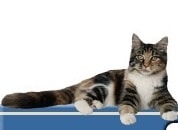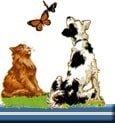


 |
 |
 |
|||||
         |
|
|
Contents
|
|
Food Allergies
ModernDog Fall 2010
The most common food allergens for dogs are beef, wheat and corn (the gluten in wheat and corn most often causes the wheat or corn allergy). The most common food intolerance in dogs is to the lactose found in dairy. These four ingredients are estimated to account for more than 68% of canine food allergies. Not all dogs are lactose intolerant, however. Lactose intolerance has more to do with age. Puppies easily digest lactose, which is contained in their mom’s milk. If you continue to give a dog milk products regularly (once a week or so) throughout his life, he will maintain his ability to digest lactose. Many adult dogs do not regularly eat ice cream, cheese or milk, though, so when people give adult dogs a milk treat the dogs tend to have a digestive upset. If your dog has a milk intolerance, you can give him Lactaid pills with his milk treat. Milk products that don’t have lactose include live culture yogurt and aged cheddar cheese. |
| Back to Top |
|
Cat Facts
CatFancy October 2010
|
| Back to Top |
|
Feline Folklore
Erika Sorocco, CatFancy October 2010
|
| Back to Top |
|
Why do Dogs Eat Grass?
ModernDog Fall 2010
Because they like to! Some dogs consider grass a salad bar and like to snack on it from time to time. Other dogs seem to have a taste for grass only when they’re nauseated. If your dog vomits every time he eats grass, don’t let him eat it. He does not “need” to eat grass to help him vomit. If he’s going to vomit, he’ll manage just fine on his own, without the grass’s help. Also, if you know or even suspect that the grass has been treated recently with pesticides or fertilizers, don’t let your dog graze. |
| Back to Top |
|
The Cost of Pet Ownership
The Frederick News-Post September 19, 2010
What does the annual cost of owning a dog or cat amount to? You must factor in providing your pet with appropriate veterinary care, nutrition, exercise, grooming, and overall pet care. When you total up these expenses, the average cat owner spends approximately $900 each year, while the typical dog owner will spend about $1,500. These figures don’t include emergencies or care for senior pets, which can be much more. When budgeting for pet care, it is always a good idea to factor in an amount for unexpected or emergency situations.
|
| Back to Top |
